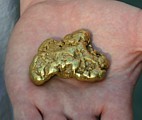
Nevada Opal: Part I, Virgin Valley
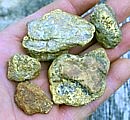
 |
Nevada Opal: Part I, Virgin Valley |
 |
Nevada has produced some very beautiful opals: This is Part I covering the famous Virgin Valley deposits......
Nevada is famous for its beautiful, colorful black Opal. The state contains some very rich precious opal beds and has produced some spectacular and extremely valuable specimens. The Virgin Valley opal beds in northwest Humboldt County are perhaps the most famous gemstone locality in Nevada. High quality precious opal emitting a multihued rainbow of color is found replacing wood or other plant material in this remote location. The Virgin Valley Opal field is in an isolated desert area south of Highway 140 about 25 miles southwest of Denio. Precious opal was first discovered here in 1905 and a number of claims were located at that time. Exploration of these deposits has been continued intermittently by various parties since that time. The opal field lies within an area approximately 5 miles wide and 10 miles long in certain beds outcropping along the walls and slopes of Virgin Creek Valley. |
||
| The formations here consist of volcanic ash tough and mud originally deposited in shallow lakes. The sediments are in part overlain by lava flows. The sedimentary beds have been divided into upper middle and lower divisions the upper beds contain fossil remains in the form of bones and teeth of mastodon camels and other fauna while the middle beds contain silicified wood and plant remains is principally in these middle beds that the opal occurs in the form of wood casts. These productive beds are buried by overburden sometimes as much as 100 feet thick. Many of the plant remains in the opal beds are only partly replaced by silica and still contain considerable carbonaceous material. Precious opal is sparsely and irregularly distributed throughout the deposit, but comprises only a very small part of it. |
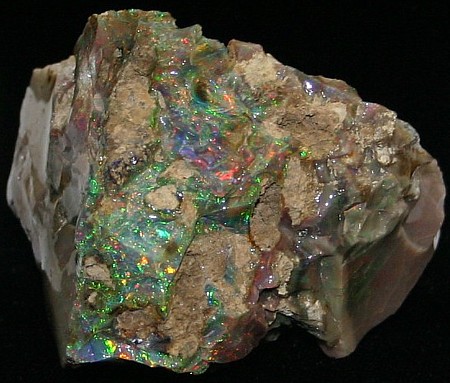 |
|
Much of the early day mining was conducted underground, but modern workings are done principally by bulldozer. Small to medium-sized open pits working around the exposed areas of the productive beds are typical of the district. Often, or the overburden becomes to deep to easily remove, the workings end. Many opal experts consider the Virgin Valley material to be some
of the best, brightest and most beautiful opal yet discovered. The Virgin Valley deposits produce a wide variety
material from intensely colored crystal opal to some of the world's finest black opal. Brilliant flashes of red, blue, yellow, green and
all the rest of the rainbow emanate from these spectacular gems. Most Virgin Valley rough has color through
out the stone (or a part of the stone). The color does not seem to occur in discreet bands
like the opal from Spencer, ID and some Australian rough. Unfortunately, Virgin Valley Opal is also famous
for its regrettable tendency to crack. All
opal contains a certain percentage of water, and the Virgin Valley Opal has an unusually
high water content often ranging from 10 to 13 % by weight.
This leads to a very undesirable tendency for the Virgin Valley opal to
slowly dry out, lose its brilliant colors and eventually crack. Most Virgin Valley
precious opal gems will eventually fail, but not every piece of Virgin Valley Opal is
destined to dehydrate and crack. Again unfortunately, it is impossible to tell simply by
looking the potential for any certain piece to self-destruct. |
||
A large number of techniques have been tried to preserve the
Virgin Valley Opal, and prevent it from cracking including various techniques to allow it
to “age” and dry slowly. Many different attempts by
a variety of individuals with all kinds of different methods and techniques to slowly dry,
treat and otherwise prevent the opal from cracking under normal conditions. However the
cracking is not a matter of a quick shock. Because the water is an integral part of the
gem, once enough water has been lost, the stone will fail – no matter how slowly the
water is lost.
|
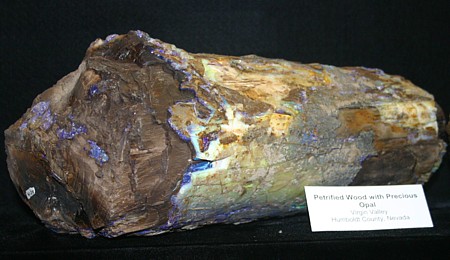 |
|
Since the Virgin Valley opals were discovered more than a century ago, loads of folks have claimed all kinds of great things as far as success in preventing them from cracking. None of these techniques have ever been proven to work over the long term. If they did, it would be big news in the gem industry as some of the Nevada opal is really colorful and they would certainly be much more valuable if they were more durable. Only those methods which fully submerge or encase the stone, preventing it from losing water, have proven reliable in the long term. Unfortunately, these do not go well with the use of this opal in jewelry. In reality, any jewelry made from Virgin Valley Opal should not be worn daily, but should worn only on special occasions, and otherwise be kept under water in order to delay dehydration as long as possible. Much of the Virgin Valley material is actually not cut into gemstones, but is simply preserved under water as a spectacular rough gem specimen. Virgin valley also has tremendous amounts of common opal. Not all of this is formed after casts of wood as the precious material is. Perhaps the best known and most valuable of the non-precious material is a golden colored translucent opal. The Common opal from the Virgin Valley area has none of the tendency to crack that the precious material does. |
||
There are areas at Virgin Valley which are open to rockhounds who would like to pay to dig for the fiery precious black opal. You have a couple of different options, tailings diggings or bank diggings. At one mine you may dig directly in the bank, while another they will dig up a section of bank, and haul the freshly dug material in for you to search through. You end up working through the opal bearing material in a safe location, and this eliminates exposing the bigger to any dangers of caving at the bank face. At the time of this writing, the three areas open for rock hounds are: 1. Rainbow Ridge Mine http://www.nevadaopal.com/ 2. Royal Peacock Opal Mine http://www.royalpeacock.com 3.
Bonanza Opal Mine
http://www.bonanzaopals.com |
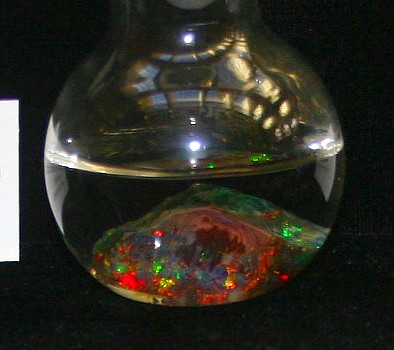 |
|
| I’ve always done better with the opal tailings than I have done digging in the bank - The bank digging is like the gambling with the Nevada slot machines - either hit it big or you get dang near nothing. People can and do find opal branches and logs worth $10,000 and more. I've I've dug in the banks and it is kind of a crapshoot - prospecting is just like that. You can pick up small but usable opal pieces with nice color off the dumps, but any real impressive stuff comes from digging in the banks. On the other hand, you can dig in the virgin bank for 3-4 days and find pretty much nothing. After all that digging someone else may come in and dig for 30 minutes in the bank just 2 feet away from your spot and find a piece worth several thousand dollars. You just never know. As an example, on the last day I dug into the bank, there were about a dozen of us and only one guy had really found something nice (a nice colorful opal limb cast), a few more found some nice small pieces, similar to what might be found in the dump. The rest of us got nothing. Opal digging presents an opportunity to find a very high dollar specimen - if you are lucky. However there are no guarantees that you will find anything - it is not easy. In addition, the fees to dig in virgin bank run material are much greater than those charged for sorting through the dump material. | ||
There are no a free areas open to precious opal prospecting and collecting by rock hounds that do not wish to pay for access. Hundreds of active mining claims blanket the entire area and the owners do not take kindly to trespassers. The pay to dig fees at Virgin Valley are generally much higher than would be experienced and many other pay-dig sites open to rockhounds. Productive mining in Virgin Valley requires the removal of overlying barren beds, which can be quite deep, requiring the use of a bulldozer or other heavy equipment, and the operating costs for this type of equipment is not cheap. There is also always the chance that you will strike a fantastic find and come up with a $50,000 precious opal log. The road into the opal area is not paved, and a high clearance vehicle is needed to drive right into the opal mine areas themselves (however, a four well drive vehicle is not necessary). There are few gas stations or other sources for supplies in the general area – it is important to be self-sufficient in this wild and remote region of northern Nevada. While there is no free digging in
the opal beds, there is a fair amount of free camping in the area. A nice free campground
with shower and pool is located at McGee hot springs. There are also plenty of things to
do, and a number of recreational activities in the Virgin Valley area. There are several
stocked ponds in the Valley available for fishing. There is sport hunting for Mule Deer
and Antelope in their season. There is a naturally heated swimming pool at McGee Hot
Springs. There are also caves to explore, fossil fields, and rock hunting for agates,
petrified wood and other gems (besides precious opal). A special wild life refuge is not
far away. There is no question that the Virgin Valley area is a very interesting one to
visit and explore. |
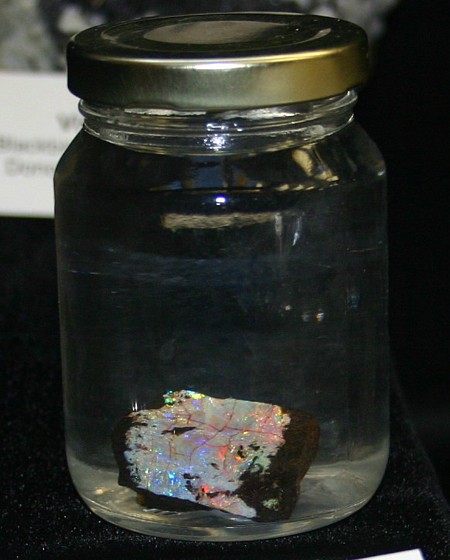 |
|
|
|
||
Want to know a little bit more about this crazy prospector guy? Well, here's a little bit more about me, and how I got into prospecting: Chris' Prospecting Story Interested in seeing natural gold? Here are some interesting photos of beautiful Gold Nuggets